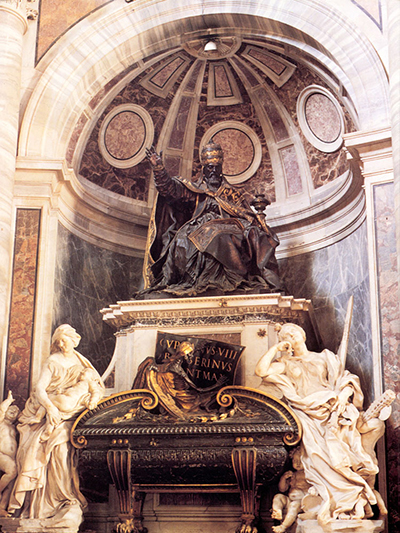The Tomb of Pope Urban VIII was made in 1647 by Bernini in memory of his greatest patron. The tomb can be found in St. Peter's basilica where Bernini and others had done much architectural and sculptural work.
The tomb is laid out in a pyramid in which a pedestal made of white marble supports a dark marble pope gilded with bronze giving a benediction. The figure of Charity sits on the left with her children and she is made of white marble. Justice with her scale and sword, also made of white marble, sits on the right.
For the first time in his work Bernini uses a skeleton to symbolise death and an unfolded scroll shows the name of the deceased pope. The parts of the tomb representing death are made in black marble with bronze gilding such as the pope and the sarcophagus. Conversely the parts of the tomb made in white marble represent living forces such as Charity and Justice. These two figures show vitality as they gracefully lean over the sarcophagus. Bees in the coat of arms of the Barberini family can be seen here as well as some other loose bees.
Pope Urban VIII had been Bernini's greatest admirer and had always fully funded the work he undertook including that of the Baldachin, a monument in the earliest period of the Baroque. Urban VIII saw Bernini as useful in his fight against the Reformation which he saw as a great threat. (He did, after all, force Galileo to recant).
Bernini's theatrical style, Urban thought, would be influential. It was the pope who persuaded Bernini to study architecture and that led to him improving the Vatican as well as many fountains in Rome. He did succeed in making the basilica into a seemingly coherent whole although there were some initial problems regarding the weight of marble.
Bernini was greatly influenced by the ancient Greek and Roman sculptures he saw in the Vatican. He was also very familiar with the work of Michelangelo. Bernini probably influenced Christopher Wren as he was very familiar with his work. This can be seen in Wren insisting on having a dome for the rebuilt St. Pauls, something entirely new in Britain.
Bernini could not have known that his great tomb for Urban VIII was to signify the end of the most highly funded part of his career although he lived into his eighties. He had made the transition from his realistic early work influenced by his sculptor father, when decorum was the desired result, to some of the greatest theatrical work in marble ever to have produced. He could work marble with fantastic skill and could make his figures seem sensuous and alive. Many tourists still visit Rome to see his work and many have pictures of it on their living room walls.




